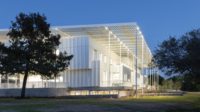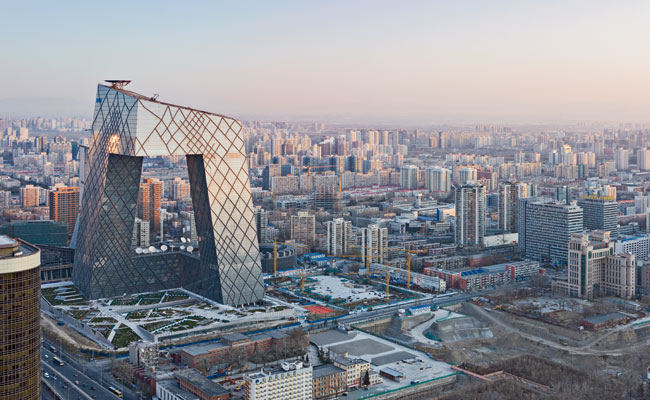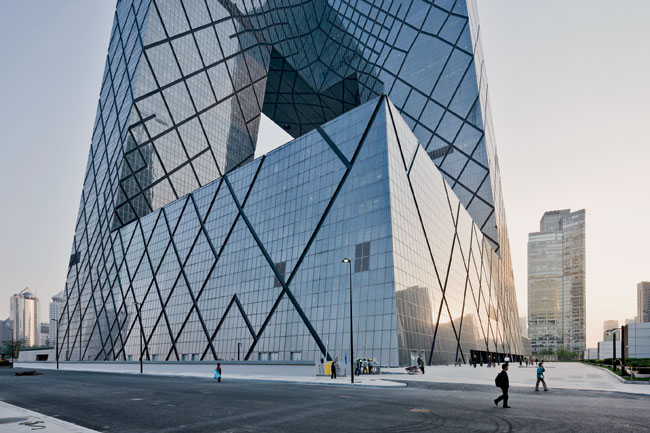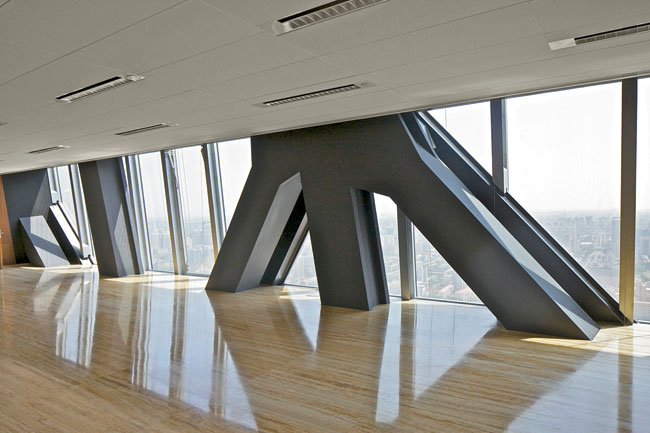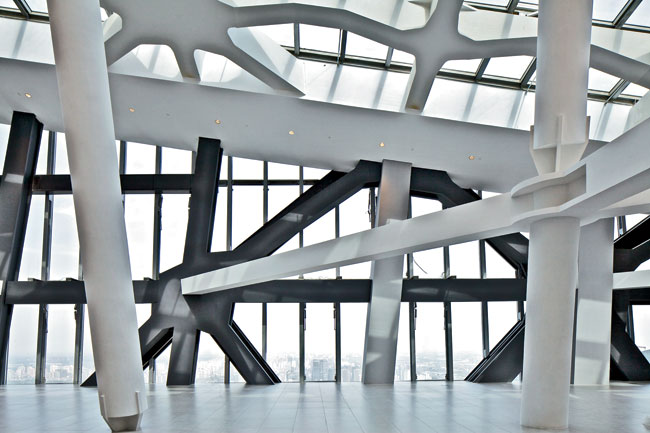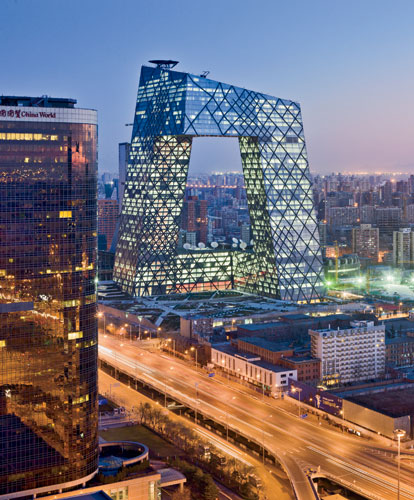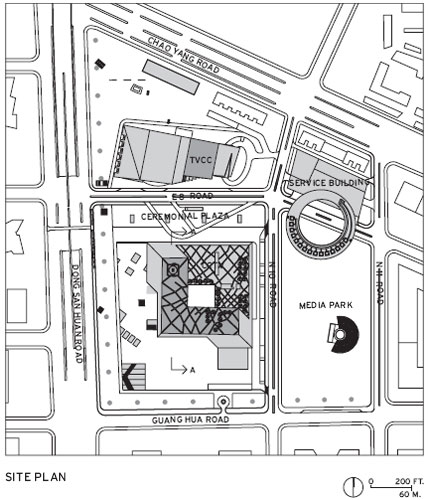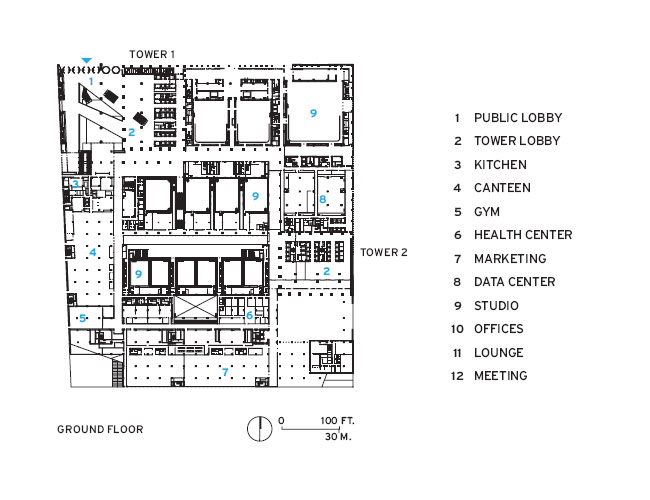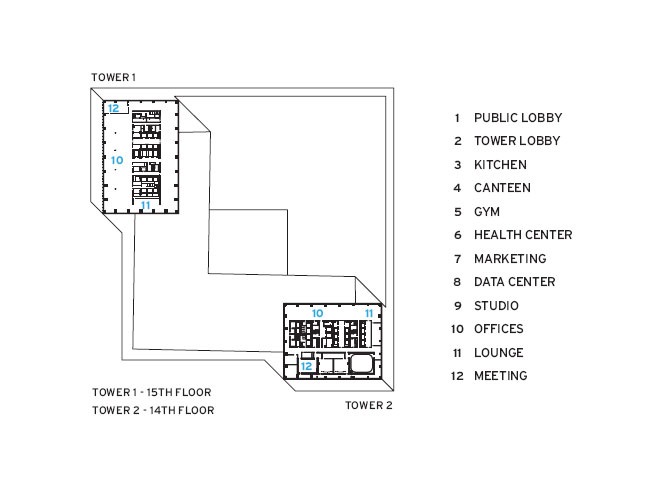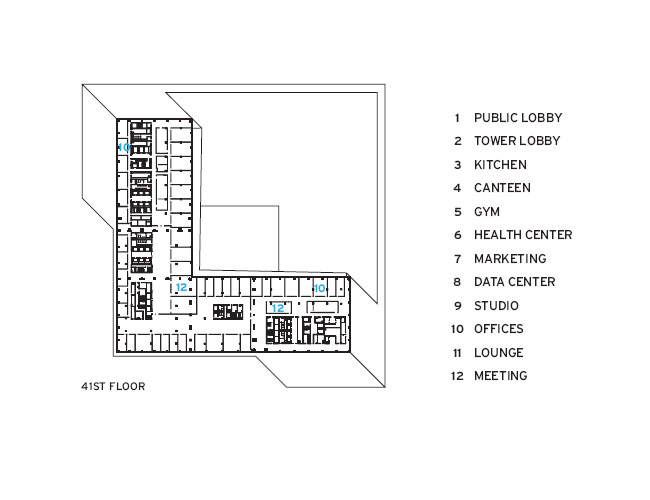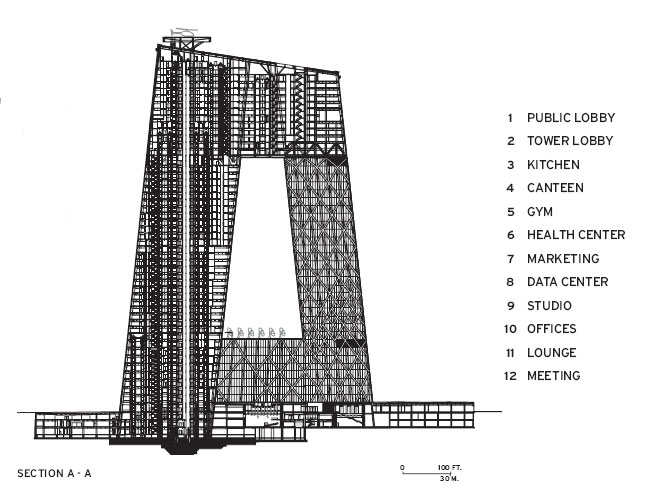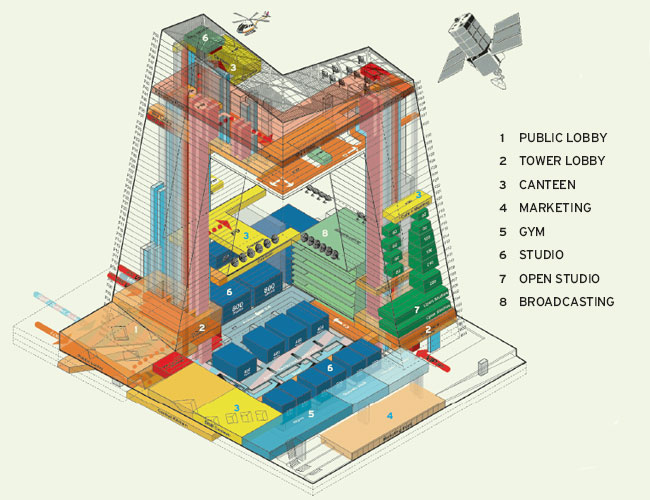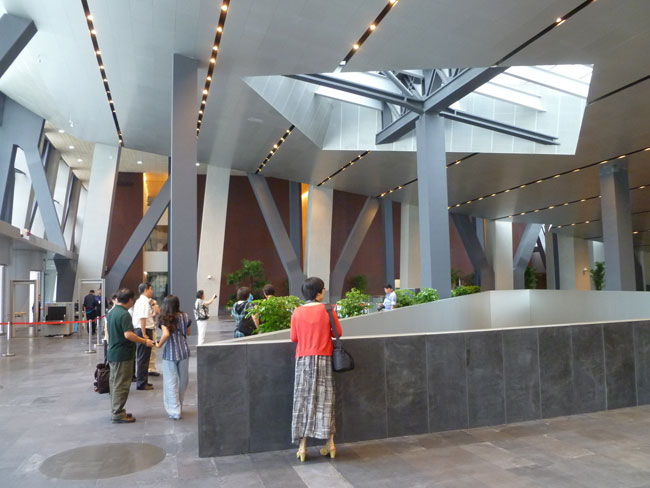CCTV Headquarters
Too Big To Fail?: Long awaited and much debated, the enormous headquarters for CCTV finally opens, already a symbol of the new Beijing. But what does it actually say about architecture and China today?


















































Architects & Firms
Beijing
Promising to “kill the skyscraper,” Rem Koolhaas and his colleagues at Office for Metropolitan Architecture (OMA) grabbed international attention in 2002 when they won the competition to design a huge headquarters in Beijing for China Central Television (CCTV), the state-run news and entertainment network. Polemical and hyperbolic as usual, Koolhaas said the skyscraper had become “corrupted” by its proliferation around the world and “negated by repetitive banality.” So instead of joining the race to build ever taller, his scheme bent the high-rise into a loop of interconnected activities. Four years after it was originally scheduled to open—in time for the network to broadcast the Beijing Olympics from its new home—CCTV is finally moving employees into the controversial building, a 5.1 million-square-foot structure that even before it was completed had imprinted its swaggering form on the fabric of the city and the mental map of its citizens.
The site anchors a new central business district emerging from an industrial area built during the Mao era. Plans call for about 300 high-rises there, which is one reason why OMA took a different approach with CCTV. According to Koolhaas, three of the four other firms competing for the job (KPF, SOM, and Dominique Perrault) proposed skyscrapers, while only Toyo Ito offered something different (a disc-shaped structure with a small tower). 'The form of our building was attractive to the client,' says Koolhaas. 'It set us apart.'
That form derived from OMA's program-driven approach to design. 'We presented the building as a diagram of all the company's components and made the argument that it was important that they confront each other,' says Koolhaas. Earlier, OMA had worked for Universal Studios on a headquarters in Los Angeles and learned that media companies often suffer from being fragmented. So the firm connected CCTV's operations'including broadcasting, production, and administration'along a circulation loop that moved from the building's base up a sloping tower, across a right-angled bridge (called the overhang), and down a second sloping tower. The underground podium and large, right-angled base provided much more contiguous space for studios and production facilities than a skyscraper would have, which appealed to the client's technology people, reports Koolhaas.
The OMA team was led by Koolhaas, Ole Scheeren (a partner until he left the firm in 2010), partner David Gianotten, and project manager Dongmei Yao. The firm worked closely with East China Architectural Design & Research Institute, which provided both architecture and engineering input.
From the beginning of the design process, OMA collaborated with Cecil Balmond and a team of engineers at Arup. To resist the huge forces generated by two towers'each sloping six degrees in two directions'as well as significant potential seismic and wind events, Arup devised a scheme that turns the entire exterior into a continuous structural tube. This system is formed by a web of diagonal steel braces that expresses the pattern of forces acting on the building and serves as an important visual element on all of the facades. Where structural forces are greater, the web of braces is denser; where the forces are less intense, the web is looser. As a result, the exterior surfaces read as a kind of engineering map with a formal beauty of its own.
While the towers and exterior braces are angled, the interior cores' housing elevators, stairs, and risers are vertical. Arup and OMA had considered canting these elements as well, but the cost of angled elevators made it unfeasible. In addition to the cores, vertical columns support the towers' floor plates. Because the towers slant, these vertical columns can't rise the full height of the building. So two-story-deep trusses transfer loads at roughly halfway up the structure, and a two-story-deep transfer deck in the overhang carries loads from vertical columns to the external tube structure.
The architects clad the building in fritted glazing that reduces solar loads inside and creates a monolithic surface that mimics Beijing's notoriously gray skies. Most curtain-wall buildings in big Chinese cities look dirty almost immediately, but CCTV's glazing handles the pollution by blending in. Combined with the irregular pattern of the external bracing that obscures floor levels, the glass skin makes it hard to grasp the building's scale. In certain light and at certain distances, the 768-foot-tall structure seems almost to disappear. Yet seen from other angles and at other times of the day, it looms aggressively over apartment blocks. 'From wherever you look at it, it keeps changing in form,' says Scheeren. 'It escapes a singular definition.'
'In a city with a strong and permanent identity, it introduces a degree of uncertainty,' says Koolhaas. 'It changes from every angle'sometimes looking robust, sometimes fragile.' Although gigantic in square footage, it would have been almost three times as tall (about 2,300 feet) if it had been a single tower'nearly 700 feet taller than the Shanghai World Financial Tower, currently the tallest building in China. Its ambiguous scale informs even the nickname local residents have given it: da kucha, or 'big undershorts.' For many years, its radical design alienated the local architectural establishment, which complained that OMA and other foreign firms use China as a laboratory for alien experiments.
While big-name architects usually design only the shell and core on high-rise projects, OMA did the CCTV interiors too. Because of the complex's vast size, the firm approached the interiors as a combination of generic and specific spaces. Entering from a plaza between CCTV and TVCC, visitors are dwarfed by the unstable-looking forms, then get a visual jolt from the dynamic lobby with its angled ceilings and imposing skylights. People arriving by subway emerge here too, ascending an escalator into the dramatic space. A public loop takes visitors past broadcast studios identified by colored panels set behind glass, through halls made grand by steel arcades, and eventually to the spectacular overhang, where'if they dare'they can walk over clear glass discs set in the floor and look 37 stories down. Throughout, OMA used a simple palette of materials to help with navigation, wrapping one tower's core in Cor-Ten and the other in aluminum, and cladding floors in public spaces with creamy travertine.
Koolhaas has been attacked by some people for working for the mouthpiece of the Chinese Communist Party. But he says, 'We are part of a generation of architects that for the first time is able to work on a global scale, and that means engaging different kinds of regimes. Our work is based on a longer engagement, as these countries change.'
Has CCTV killed the skyscraper? Of course not'a fact made clear by the towers starting to crowd around it. But it offers an intriguing alternative, one that uses its odd geometry to provoke questions of architectural etiquette'such as how to fit into (and stand out from) a context in flux. Its awkward form, though, grows on you, like a geeky classmate who might seem strange at first but increasingly smart as you get to know him. The audacity of the building's structural gymnastics and its innovative approach to scale and expression could only happen right now in China, a country trying hard to convert its cash reserves into global prestige and one where clients are willing to assume high levels of risk. CCTV represents a remarkable moment in Beijing's history, one that may already be slipping away as China's radical transformation slows.
An engineering marvel, CCTV flaunts its technological prowess in its radical geometry and exposed steel bracing. And its most daring structural element is the 'overhang,' a nine-to-13-story bridge that makes a right turn in midair as it spans the gap between the two angled towers. Looming 37 stories above the ground, it juts out 245 feet from one tower and 220 feet from the other. During construction, the two arms of the overhang were cantilevered from the towers before being connected to form a more stable bridge and complete the building's continuous structural tube. Making that connection was a dramatic moment during construction and required a precise fit. Because the sun warms and expands the steel in each part of the building at a different time during the day, construction workers had to complete the task early in the morning when the arms are the same temperature. Visitors today who take the public tour through CCTV get a visceral understanding of the engineering feat when they arrive at the overhang and walk over three clear glass discs set in the deck of the 37th floor. A veritable forest of exposed steel bracing here also helps bring the construction story alive for anyone visiting the space. —C.A.P.
| Photo ' Philipp e Ruault (left); Photo ' Iwan Baan (right) | |
| On the 37th floor in the overhang, visitors can walk over glass portals and look down to the plaza (left). Exposed steel bracing forms a continuous tube structure that resists the huge forces generated by the building’s cranked and leaning forms. (right) | |
PeopleOwner: China Central Television
Architect:
Personnel in architect's firm who should receive special credit: The design team consisted of project architects Anu Leinonen, Charles Berman and Adrianne Fisher together with Design team(A-Z): Alain Fouraux, Arianna Spaccasassi, Antonio Teles Branco, Beatrice Schiavina, Beatriz Ramo Lopez, Catarina Canas, Charles Gosrisirikul, Chris James, Christina Murphy, Chris van Duijn, Daan Ooievaar, Dan Cheong, Dirk Zschunke, Dorthee Dietz, Erez Ella, Fang Tieying, Faustina Tsai, Feng Pei, Fernando Donis; Florian Pucher, Gabriela Bojalil, Gaspard Estourgie, Georg Bucher, Gonzalo Laurentiu Coceanga, Hendrik Gruss, Guillaume Colboc, Hiromasa Shirai, Holly Chacon, James Harper, Jasmine Tsoi, Jeffrey Bolhuis, Joao Bravo Da Costa, Joao Gomes Branco Teodosio, Johannes Buchholz, Joris Fach, Joseph Monteleone, Keren Engelman, Kam Fai Tai, Laurent Troost, Lawrence Leung, Li Guilin, Liu Xiaodong, Lodewijk van Eeghen, Loy Tsao, Mamen Escorihueles, L. E. Tsao, Manuel Shvartzberg, Max Burianek, Max Rink, Max Schwitalla, Melissa Dowler, Menno van der Meer, Michel van der Kar, Paul Burgstaller , Paul Kroese, Pedro Costa Gama, Peter Lee ,Roberto Otero, Rodrigo Nunez Carrasco, Rodney Eggleston, Sarah Gibson, Shi Wenchian, Shiro Ogata, Steffen Ell, Steffie Wedde, Steven Smith, Stuard Maddox, Suse Koch, Tammo Prinz, Ted Lin, Tim Callaghan, Torsten Schroeder, Victoria Willocks, Wang Xinyuan, Wang Yunzhu, Wu You, Xu Tian Tian, Yimin Zhu, Yiannis Kanakakis, Yu Long, Zhaohui Wu; and Support team (A-Z): Lisa Aalders, May Yan Fan, Li Dan, Liu Aoshuang, Liu Yonghong, Sun Yongzhen, Ou Qiang, Wang Yimeng, Wang Yu, Wu Xinghua, Xu Yi, Zhang Yajuan, Zhao Xiaoyue Architect of record : OMA/ECADI Interior designer: OMA/ECADI Engineer(s): ARUP/ECADI—Cecil Balmond, Chris Carroll, Michael Kwok, Rory McGowan, Paul Cross, Xiaonian Duan, Craig Gibbons, Goman Ho, Richard Lawson, Alexis Lee, Andrew Luong, Chas Pope, design team
Local design institute:
Consultant(s):
Others: General contractor: China State Construction Engineering Corporation
Photographer(s):
Renderer(s):
CAD system, project management, or other software used: Size: 5.1 million square feet Cost: $795 million'$900 million Completion date: May 2012 |
Products
Structural system
Jiang Su Huning Steel Mechanism CO. Ltd. Exterior cladding at plinth: BROWN TRAVERTINE
MANUFACTURER:Yingliang Stone Co., Ltd.
Metal/glass curtain wall system: Beijing Jangho Curtain Wall CO., LTD
Glazing:
Stone paving and stone laminated Ceiling in lobbies: Yellow travertine
Stone laminated ceiling fabricator:
Tower 1 core cladding: Corten: 3mm thick corten
Lighting (major brand used)
Elevators/Escalators: SHANGHAI MITSUBISHI ELEVATOR |


